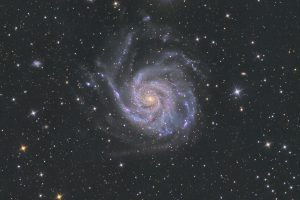
A team of Johns Hopkins researchers has developed a cutting-edge data science approach capable of matching observations of celestial objects taken across multiple telescope surveys, overcoming a significant challenge in modern astronomy. This new tool has the potential to enhance the accuracy and reliability of astronomical catalogs, opening doors to deeper insights into the universe and its celestial bodies.
The team’s results appear in The Astronomical Journal: “Fast Globally Optimal Catalog Matching using MIQCP”
“Much of our basic understanding of nature comes from these astronomical observations, so it is important to have accurate and reliable inferences about the properties of space and celestial objects out there from the raw astronomical observations,” said team member Tamas Budavári, an associate professor in the Whiting School of Engineering’s Department of Applied Mathematics and Statistics. “This new tool is a step toward making those observations more reliable for astronomy studies.”
Budavári worked on the study with Amitabh Basu, a professor of applied mathematics and statistics and instructor in the Whiting School of Engineering’s Engineering for Professionals Program, and first author Jacob Feitelberg, who was a master’s degree student at Johns Hopkins when the study was conducted.
The team sought to overcome a fundamental problem in astronomy: Different telescopes capturing multiple exposures of the same sky region under different conditions can provide extra insights but are prone to inaccuracies in measurements. Furthermore, when two or more celestial objects in proximity are measured, observations can become intermingled, presenting a complex computational problem.
To address this challenge, the team used a sophisticated data science approach that involves assigning a “score” to each pair of observations from two separate surveys.
“For every observation from survey 1 and survey 2, we give this pair a ‘score,’ which measures the likelihood that these observations were of the same celestial object. This likelihood increases if the two observations are closer to each other in terms of their angular distance in the sky and decreases rapidly as the two observations get farther from each other,” explained Basu.
This method effectively matches observations from different surveys to maximize the combined likelihood that they are of the same object, overcoming the computationally difficult task of exhaustively searching through all possible pairings. The researchers say that this breakthrough dramatically speeds up the matching process and can handle vast datasets, making it invaluable for handling large-scale astronomical surveys.
“We managed to outperform previous approaches when it came to finding accurate matches between observations. The previous methods were fast but didn’t consider all possible combinations so they couldn’t guarantee the best matches with the highest likelihoods,” said Budavári. “Our new method, on the other hand, is just as fast but comes with a proven guarantee of accuracy and delivers superior results when applied to real datasets.”
Team members emphasize that the accuracy and reliability of inferences drawn from astronomical observations are essential for our understanding of the universe.
“These observations are fundamental to building theories about the universe, from the smallest particles to the vast cosmos. By matching observations across time and telescopes, researchers can extract more knowledge from the same data, contributing to a deeper understanding of the cosmos,” Budavári said.
The team said that while the potential of this new method is clear, its broader adoption and integration into astronomical research practices will depend on further validation and consensus within the astronomy community.
“However, our approach opens exciting possibilities for improving the precision of celestial object matching in astronomy, ultimately enhancing our understanding of the universe,” Basu said.
The team intends to further enhance this method to handle a much larger number of surveys, far beyond the current 50 to 100.
“While previous exact methods could handle 10 to 20 catalogs, our new method allows us to process up to 100 catalogs,” said Feitelberg, now a doctoral student at Columbia University. “Our new tool is the first exact method which is fast enough to start using on real-world catalogs.”
Interested in learning more about JHU Engineering for Professionals programs? Reach out to our admissions team today!